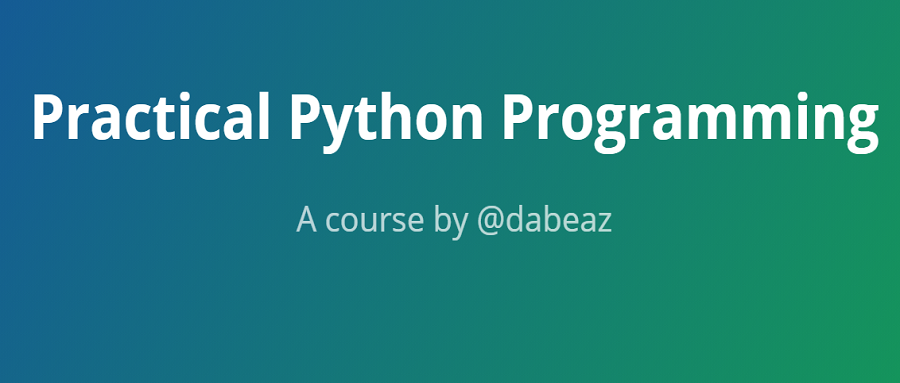目录 | [上一节 (5.2 封装)]| [下一节 (6.2 自定义迭代)]
6.1 迭代协议
本节将探究迭代的底层过程。
迭代无处不在
许多对象都支持迭代:
a = 'hello'for c in a: # Loop over characters in a ...
b = { 'name': 'Dave', 'password':'foo'}for k in b: # Loop over keys in dictionary ...
c = [1,2,3,4]for i in c: # Loop over items in a list/tuple ...
f = open('foo.txt')for x in f: # Loop over lines in a file ...
复制代码
迭代:协议
考虑以下 for 语句:
for x in obj: # statements
复制代码
for 语句的背后发生了什么?
_iter = obj.__iter__() # Get iterator objectwhile True: try: x = _iter.__next__() # Get next item # statements ... except StopIteration: # No more items break
复制代码
所有可应用于 for-loop 的对象都实现了上述底层迭代协议。
示例:手动迭代一个列表。
>>> x = [1,2,3]>>> it = x.__iter__()>>> it<listiterator object at 0x590b0>>>> it.__next__()1>>> it.__next__()2>>> it.__next__()3>>> it.__next__()Traceback (most recent call last):File "<stdin>", line 1, in ? StopIteration>>>
复制代码
支持迭代
如果想要将迭代添加到自己的对象中,那么了解迭代非常有用。例如:自定义容器。
class Portfolio: def __init__(self): self.holdings = []
def __iter__(self): return self.holdings.__iter__() ...
port = Portfolio()for s in port: ...
复制代码
练习
练习 6.1:迭代演示
创建以下列表:
请手动迭代该列表:先调用 __iter__() 方法获取一个迭代器,然后调用 __next__() 方法获取下一个元素。
>>> i = a.__iter__()>>> i<listiterator object at 0x64c10>>>> i.__next__()1>>> i.__next__()9>>> i.__next__()4>>> i.__next__()25>>> i.__next__()16>>> i.__next__()Traceback (most recent call last): File "<stdin>", line 1, in <module>StopIteration>>>
复制代码
内置函数 next() 是调用迭代器的 __next__() 方法的快捷方式。尝试在一个文件对象上使用 next() 方法:
>>> f = open('Data/portfolio.csv')>>> f.__iter__() # Note: This returns the file itself<_io.TextIOWrapper name='Data/portfolio.csv' mode='r' encoding='UTF-8'>>>> next(f)'name,shares,price\n'>>> next(f)'"AA",100,32.20\n'>>> next(f)'"IBM",50,91.10\n'>>>
复制代码
持续调用 next(f),直到文件末尾。观察会发生什么。
练习 6.2:支持迭代
有时候,你可能想要使自己的类对象支持迭代——尤其是你的类对象封装了已有的列表或者其它可迭代对象时。请在新的 portfolio.py 文件中定义如下类:
# portfolio.py
class Portfolio:
def __init__(self, holdings): self._holdings = holdings
@property def total_cost(self): return sum([s.cost for s in self._holdings])
def tabulate_shares(self): from collections import Counter total_shares = Counter() for s in self._holdings: total_shares[s.name] += s.shares return total_shares
复制代码
Portfolio 类封装了一个列表,同时拥有一些方法,如: total_cost property。请修改 report.py 文件中的 read_portfolio() 函数,以便 read_portfolio() 函数能够像下面这样创建 Portfolio 类的实例:
# report.py...
import fileparsefrom stock import Stockfrom portfolio import Portfolio
def read_portfolio(filename): ''' Read a stock portfolio file into a list of dictionaries with keys name, shares, and price. ''' with open(filename) as file: portdicts = fileparse.parse_csv(file, select=['name','shares','price'], types=[str,int,float])
portfolio = [ Stock(d['name'], d['shares'], d['price']) for d in portdicts ] return Portfolio(portfolio)...
复制代码
接着运行 report.py 程序。你会发现程序运行失败,原因很明显,因为 Portfolio 的实例不是可迭代对象。
>>> import report>>> report.portfolio_report('Data/portfolio.csv', 'Data/prices.csv')... crashes ...
复制代码
可以通过修改 Portfolio 类,使 Portfolio 类支持迭代来解决此问题:
class Portfolio:
def __init__(self, holdings): self._holdings = holdings
def __iter__(self): return self._holdings.__iter__()
@property def total_cost(self): return sum([s.shares*s.price for s in self._holdings])
def tabulate_shares(self): from collections import Counter total_shares = Counter() for s in self._holdings: total_shares[s.name] += s.shares return total_shares
复制代码
修改完成后, report.py 程序应该能够再次正常运行。同时,请修改 pcost.py 程序,以便能够像下面这样使用新的 Portfolio 对象:
# pcost.py
import report
def portfolio_cost(filename): ''' Computes the total cost (shares*price) of a portfolio file ''' portfolio = report.read_portfolio(filename) return portfolio.total_cost...
复制代码
对 pcost.py 程序进行测试并确保其能正常工作:
>>> import pcost>>> pcost.portfolio_cost('Data/portfolio.csv')44671.15>>>
复制代码
练习 6.3:创建一个更合适的容器
通常,我们创建一个容器类时,不仅希望该类能够迭代,同时也希望该类能够具有一些其它用途。请修改 Portfolio 类,使其具有以下这些特殊方法:
class Portfolio: def __init__(self, holdings): self._holdings = holdings
def __iter__(self): return self._holdings.__iter__()
def __len__(self): return len(self._holdings)
def __getitem__(self, index): return self._holdings[index]
def __contains__(self, name): return any([s.name == name for s in self._holdings])
@property def total_cost(self): return sum([s.shares*s.price for s in self._holdings])
def tabulate_shares(self): from collections import Counter total_shares = Counter() for s in self._holdings: total_shares[s.name] += s.shares return total_shares
复制代码
现在,使用 Portfolio 类进行一些实验:
>>> import report>>> portfolio = report.read_portfolio('Data/portfolio.csv')>>> len(portfolio)7>>> portfolio[0]Stock('AA', 100, 32.2)>>> portfolio[1]Stock('IBM', 50, 91.1)>>> portfolio[0:3][Stock('AA', 100, 32.2), Stock('IBM', 50, 91.1), Stock('CAT', 150, 83.44)]>>> 'IBM' in portfolioTrue>>> 'AAPL' in portfolioFalse>>>
复制代码
有关上述代码的一个重要发现——通常,如果一段代码和 Python 的其它代码"类似(speaks the common vocabulary of how other parts of Python normally work)",那么该代码被认为是 “Pythonic” 的。同理,对于容器对象,其重要组成部分应该包括:支持迭代、可以进行索引、对所包含的元素进行判断,以及其它操作等等。
目录 | [上一节 (5.2 封装)]| [下一节 (6.2 自定义迭代)]
注:完整翻译见 https://github.com/codists/practical-python-zh













评论